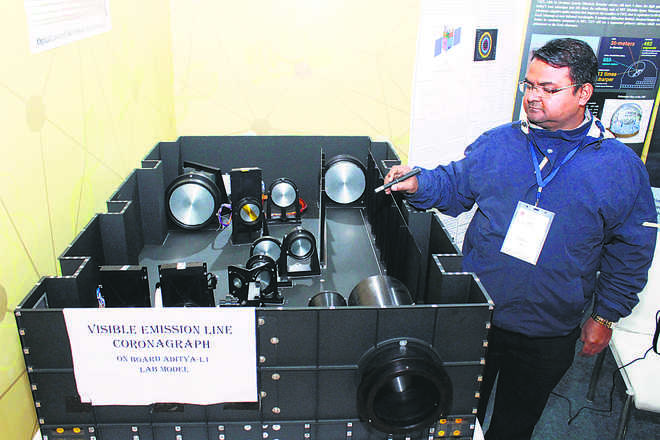Mission on Sun’s corona in 2020

The Indian Institute of Astrophysics (IIA), Bengaluru, in association with Indian Space Research Organisation (ISRO) will in 2020 launch the country’s first mission to study the chemical composition of Sun’s corona and various heat-generating reactions around it.
While such missions are currently being undertaken by US space agency NASA, India will send out a coronagraph aboard Aditya-L1 satellite, the first Indian mission to study the Sun.
Amit Kumar from the IIA, who is at an expo being organised by Indian Science Congress at Lovely Professional University, showed a laboratory model of the project and said the coronagraph in titanium (having less thermal expansion), weighing 175 kg, was being readied that will set out on a 1.5 million-km journey from the Earth.
“It has seven types of optical assemblies, including deflectors and cameras, which will create a spectrum that will help study the chemicals in the corona.
“We know that hydrogen and helium are largely present but there are some metals too, including calcium and iron. It will be positioned to face the Sun in such a way that artificial eclipse gets created and only corona light enters.
We will study the reactions that lead to solar flares. We will also try to find out as to how long the Sun will give us warmth.” The IIA scientists are also working on a “30-metre telescope” (equal to a 100-foot mirror), which will have 156 times more collecting area than the Hubble Space Telescope, producing 12 times sharper image. The telescope is coming up in collaboration with the US, Canada, China and Japan.
India has contributed Rs 1,500 crore to the project, in addition to providing 92 mirrors to be used in it. Telescope-control and dome-control softwares too are being created by the IIA in association with four other companies, including TCS and Honeywell. Kumar said the telescope would be placed atop a peak in Hawaii, US, and the mission is scheduled for 2027.
“The site has been chosen as it is a cold desert sans any pollution and the atmosphere there is very thin, suitable for the best view. The mission is to find Earth-sized, terrestrial, habitable planets around other stars,” said the expert at the expo.
Courtesy : The Tribune
